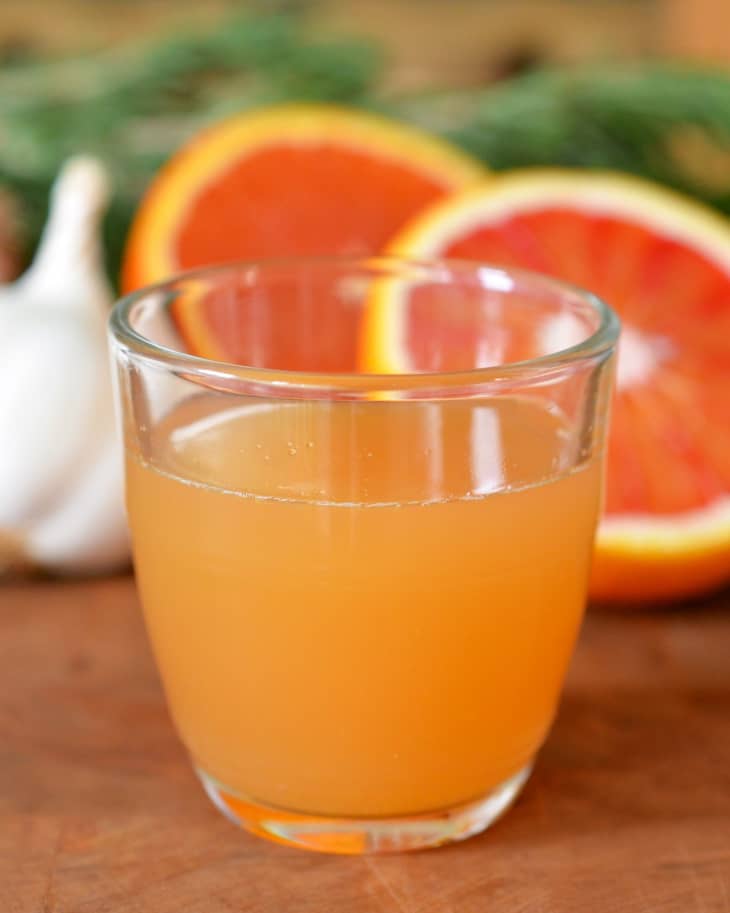Fire Cider

Have you heard of fire cider? The first time I encountered this traditional folk recipe, I have to admit I was terrified. Horseradish, garlic, onion, ginger, hot peppers, and spices infused in apple cider vinegar? To drink? It took me years before I tried it, but you can be braver than me. It’s worth it! Plus you can use fire cider in so many ways — from cold cure to cooking to cocktails.
Consuming Fire Cider
Hot, pungent, sour, and sweet, fire cider is certainly not for the faint of heart. Yet this fiery concoction has been revered for generations of people who used it as a remedy to relieve sinus congestion, ward off colds and flus, aid digestion, and increase circulation. There is very little peer-reviewed research supporting any health benefits, but the practice of drinking fire cider has a passionate following nonetheless.
Fire cider can be sipped neat on its own, mixed with other beverages, or used in cooking. You might think of it like a savory shrub. It’s especially useful to have fire cider on hand in cold weather.
Fire Cider Ingredients
As a folk remedy there are countless variations, but most fire cider recipes include ingredients like fresh horseradish, garlic, onion, ginger, and chile pepper. These are infused in apple cider vinegar (vinegar draws out many plant constituents), which is then strained and sweetened with honey.
My recipe is based on a fire cider recipe popularized by herbalist Rosemary Gladstar. In addition to the ingredients mentioned above, I like to add turmeric, citrus, and herbs like parsley, rosemary, and thyme. Together they form a potent punch that is immune-boosting, antibacterial, antiviral, congestion clearing, and warming.
I really encourage you to have fun and create your own fire cider according to your tastes and available ingredients. In fact, I make it a little different every time. In some batches I use spices like cinnamon and cardamom or add vitamin C-rich rose hips. Other times I use ground cayenne or dried chiles rather than fresh habaneros or jalapenos. If you use ground chile, start with a small pinch; you can always add more to taste after you strain the vinegar.
If you’re a fan of spicy foods, you might take to fire cider right away, tossing back shots to get your blood flowing on a cold winter day. If you have a more timid palate, you might want to dial back on the chile, sweeten with extra honey, and start with small dashes of fire cider in your food rather than drinking it straight.
A Few Serving Suggestions
- Straight up: Rosemary Gladstar recommends taking 1 to 2 tablespoons at the first sign of a cold, and then repeating every 3 to 4 hours until symptoms subside. Some people also take fire cider as a preventative during cold and flu season.
- Mix with lemonade or orange juice
- Mix with hot water and extra honey to make a tea
- Use in place of vinegar in salad dressings and condiments (like this fire cider honey mustard at Salt+Fat+Whiskey)
- Drizzle on steamed vegetables or sautéed greens
- Use in marinades for meat, tofu, and tempeh
- Add to soups and chilis
- Try a couple of dashes in a cocktail, such as a Bloody Mary
Are you inspired to make fire cider now? I’d love to hear what you put in yours and how you use it.
Fire Cider
Makes 1 pint or more
Nutritional Info
Ingredients
- 1/2 cup
peeled and diced horseradish
- 1/2 cup
peeled and diced garlic
- 1/2 cup
peeled and diced onion
- 1/4 cup
peeled and diced ginger
- 1/4 cup
peeled and diced turmeric
- 1
habanero chile, split in half
- 1
orange, quartered and thinly sliced crosswise
- 1/2
lemon, quartered and thinly sliced crosswise
- 1/2 cup
chopped parsley
- 2 tablespoons
chopped rosemary
- 2 tablespoons
chopped thyme
- 1 teaspoon
black peppercorns
- 2 to 3 cups
raw unfiltered apple cider vinegar (at least 5% acidity)
- 1/4 cup
raw honey, or more to taste
Instructions
Place all of the vegetables, fruits, herbs, and spices in a clean 1-quart jar. Fill the jar with vinegar, covering all the ingredients and making sure there are no air bubbles. Cap the jar. If using a metal lid, place a piece of parchment or wax paper between the jar and the lid to prevent corrosion from the vinegar. Shake well.
Let the jar sit for 3 to 6 weeks, shaking daily (or as often as you remember).
Strain the vinegar into a clean jar. Add honey to taste. Refrigerate and use within a year.
